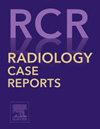Microvascular dysfunction causing myocardial ischemia in obstructive hypertrophic cardiomyopathy
Q4 Medicine
引用次数: 0
Abstract
Hypertrophic cardiomyopathy (HCM) is characterized by myocardial hypertrophy and can lead to significant complications including left ventricular outflow tract obstruction (LVOTO) and myocardial ischemia. Microvascular dysfunction (MVD) is a less recognized but crucial cause of myocardial ischemia in HCM, contributing to myocardial injury in the absence of obstructive coronary artery disease. We presented a case of a 48-year-old male with retrosternal chest tightness radiating to the left arm for 3 h. Electrocardiography revealed left ventricular (LV) hypertrophy with ST-segment depression and T wave inversion. High-sensitivity troponin T levels were elevated. Echocardiography showed marked LV wall thickness, predominantly at the basal septum, with systolic anterior motion of anterior mitral valve leaflet causing LVOTO. Adenosine stress cardiac magnetic resonance imaging demonstrated faint patchy scars in the hypertrophied ventricular septum and significant stress-induced perfusion defects beyond the area of myocardial scarring. Coronary angiography showed normal epicardial arteries, suggesting MVD as the underlying cause of ischemia. The patient was treated with nebivolol and verapamil, leading to symptom relief and a reduction in the pressure gradient of LVOTO at follow-up. This case highlights the role of MVD in causing myocardial ischemia in patients with HCM. Effective management of HCM with MVD includes pharmacological therapy to alleviate outflow obstruction and improve myocardial perfusion. Comprehensive diagnostic and treatment approaches are essential for optimizing outcomes in patients with this complex condition.
求助全文
约1分钟内获得全文
求助全文
来源期刊

Radiology Case Reports
Medicine-Radiology, Nuclear Medicine and Imaging
CiteScore
1.10
自引率
0.00%
发文量
1074
审稿时长
30 days
期刊介绍:
The content of this journal is exclusively case reports that feature diagnostic imaging. Categories in which case reports can be placed include the musculoskeletal system, spine, central nervous system, head and neck, cardiovascular, chest, gastrointestinal, genitourinary, multisystem, pediatric, emergency, women''s imaging, oncologic, normal variants, medical devices, foreign bodies, interventional radiology, nuclear medicine, molecular imaging, ultrasonography, imaging artifacts, forensic, anthropological, and medical-legal. Articles must be well-documented and include a review of the appropriate literature.
 求助内容:
求助内容: 应助结果提醒方式:
应助结果提醒方式:


